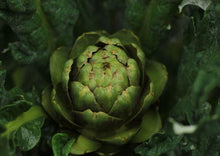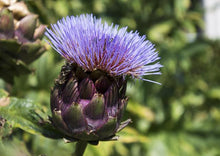An heirloom variety Artichoke that is smooth and ripe, with overwhelming flavor!
An Open Pollinated Perennial variety plant producing rich yields of tender and flavorful purple artichokes. One of the most desired and favorite gourmet variety. This plant brings an ornamental look to your home garden plus very easy to grow at home.
Planting
- Artichokes can be started from seeds, from rooted shoots taken from growing plants, or from dormant roots.
If starting from seeds:
- Start seeds indoors in late winter or early spring, about 8-10 weeks before planting outside.
- Soak the seeds in warm water before sowing in trays or pots.
- Place the trays or pots in a warm spot with bright light.
- Transplant seedlings in the garden after the last spring frost.
- Choose a spot in the garden that gets full sun.
- Artichokes are heavy feeders, add compost or aged manure into the soil before planting.
- Space each plant about three feet apart in rows.
- Water deeply at the time of planting.
Dormant roots:
- Plant dormant roots about six inches deep. The tops should be above ground level.
- Plant in the fall in frost-free regions. In cooler climates, plant roots in spring after the last frost.
Care
- Mulch around the plants to keep soil moist. Artichokes need lots of water to form edible buds.
- Apply a balanced organic fertilizer once every month during the growing season.
- Remove mulch when the plants begin to bud and side dress around the plants with compost.
- Artichoke plants will go dormant in hot weather.
- When temperatures cool off in late summer and fall, plants will start growing again you may get a second harvest.
- In cooler regions, after the fall harvest, cut plants back to about 6 inches and cover the crowns plant with leaves.
Pests / Diseases
- Bacterial crown rot: The plant stops growing and the leaves will wilt. The crown will slowly rot.
- Fungal gray mold: The crown of the plant becomes slimy and foul smelling and a white to gray mold will appear. This often occurs in humid conditions.
- Armyworms, aphids, flea beetles, loopers, spider mites, and slugs.
Harvest
- Harvest artichoke buds when they have swelled but are still closed tight.
- Use a sharp knife to cut across the stem about 1 to 2 inches below the bud.
Click here to download our free vegetable growing guide









